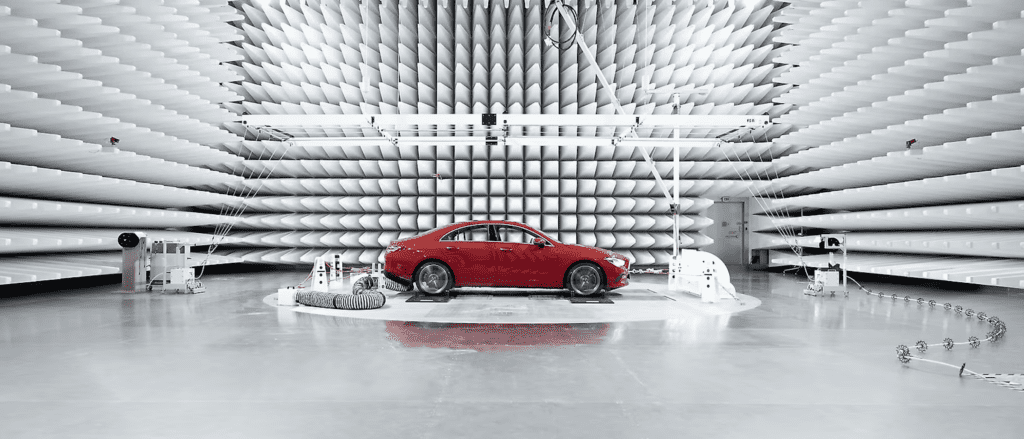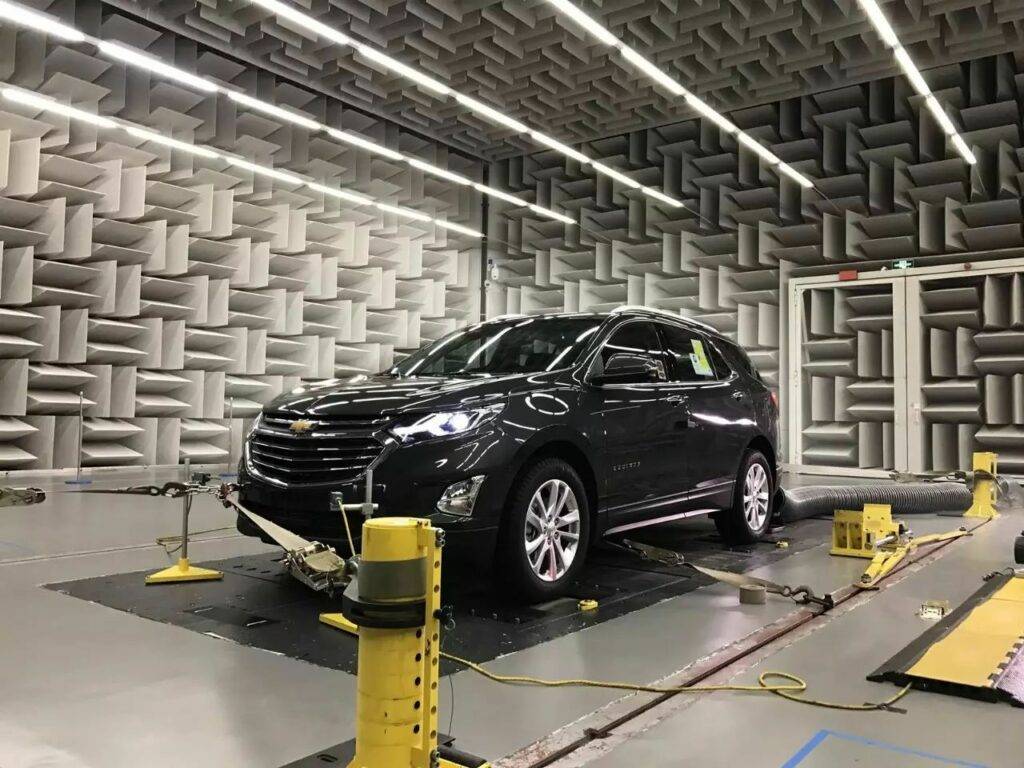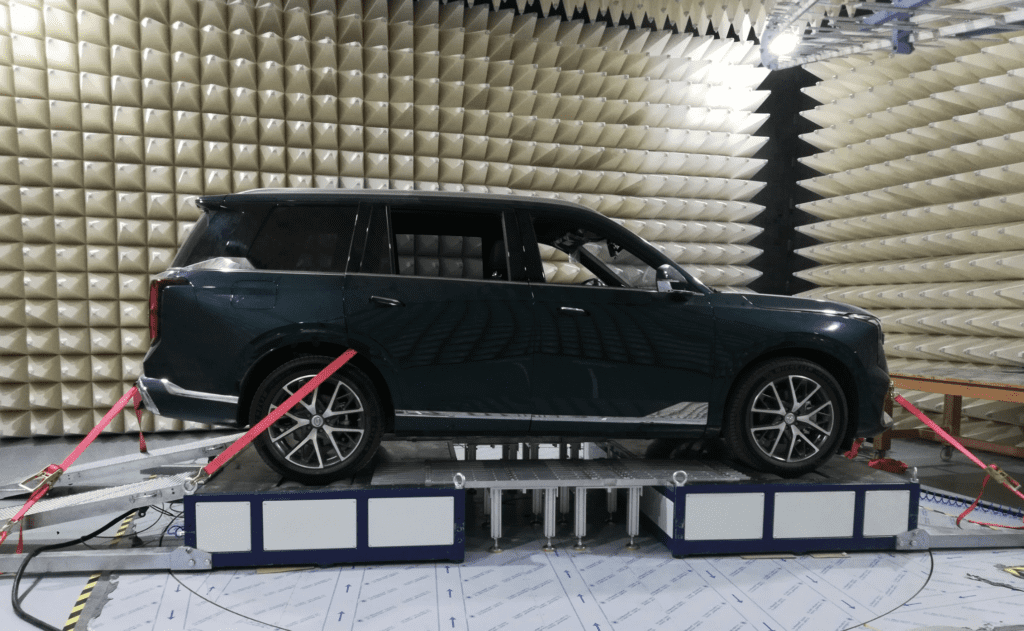EMC Testing for Automotive Electronics: Ensuring Safe and Reliable Vehicle Electronics
Elektromagnetische Verträglichkeit (EMC) is a crucial factor in the design and performance of automotive electronics. It refers to a device’s ability to function properly without causing or suffering from interference in its electromagnetic environment. In today’s cars, where electronics control everything from engine systems to entertainment features, ensuring EMC compliance is essential for smooth and reliable operation.
In the automotive industry, EMC testing is conducted to ensure that a vehicle’s electronic systems work seamlessly, without disrupting each other or being affected by external sources of interference. The goal is to prevent electromagnetic interference (EMI) that could potentially compromise the performance and safety of the vehicle.

EMC testing helps automotive manufacturers meet regulatory standards, improve product quality, and enhance vehicle safety. It ensures that the electronic components in a vehicle don’t emit unwanted electromagnetic energy that could interfere with nearby devices, like smartphones or other vehicles. Zusätzlich, it checks how well the vehicle’s electronics can withstand interference from external sources, such as mobile phones or radio signals.
Emissions Testing: This part of the testing process measures the electromagnetic energy emitted by the vehicle’s electronic components. The purpose is to identify and reduce any emissions that might interfere with other nearby electronic devices. Emissions testing ensures that the vehicle complies with global regulatory standards for electromagnetic emissions.
Immunity Testing: Immunity testing evaluates how well the vehicle’s electronics perform when exposed to external electromagnetic fields. Zum Beispiel, it simulates interference from mobile phones, radio towers, or other electronic devices. This test ensures that the vehicle’s systems remain operational and safe, even in environments filled with electromagnetic signals.
By conducting both emissions and immunity testing, automotive manufacturers can ensure that their vehicles are fully compatible with electromagnetic environments, providing a smooth and safe driving experience for customers.
Das EMV/EMI-Testsystem für Fahrzeuge besteht im Allgemeinen aus einer reflexionsarmen Kammer oder einer Nachhallkammer, Messgeräte, und ein Nabendynamosystem, das die Straßenlast des Fahrzeugs simuliert. Das rotierende Nabendynamosystem, das die Fahrzeugbelastung simuliert, kann als Zweiradantrieb ausgelegt sein, Leistungsprüfstand mit Allradantrieb oder Mehrwellenantrieb, je nach Anzahl der Antriebswellen des Fahrzeugs. Das Dynamometersystem kann auch eine in den Drehteller eingebettete Struktur annehmen, oder ein mobiler Typ.
everything needs to be tested in the lab since tests performed on real roads are expensive and not reproducible. Nevertheless, realistic driving conditions must somehow be simulated in the lab. This is leading to a huge demand for new test systems and test cases to keep pace with the growing speed of development – both for automotive manufacturers as well as their suppliers, test houses and inspection organizations.
Fixed Stationary EMC Testing System for Automotive Applications
The Fixed Stationary EMC Testing System is designed to simulate realistic driving conditions for vehicle testing, specifically focusing on electromagnetic compatibility (EMC) assessments. It consists of two main units: a drum unit and a dynamometer unit. These work together to replicate the road load before and after the vehicle, with the added flexibility of adjustable distances between the drum units.
Dynamometer Unit: The dynamometer is typically embedded within a turntable that rotates along with it or positioned within the raised floor. The dynamometer unit simulates the vehicle’s driving dynamics and road load by adjusting to the vehicle’s wheelbase and providing accurate torque or speed control during testing.
Setup Process: Before testing begins, the dynamometer’s moving axle unit is adjusted to match the vehicle’s wheelbase. The vehicle is then securely fixed into the hub using a ratchet strap, with both the front and rear of the vehicle locked in place. The exhaust pipe is connected, and testing is initiated.
Modular Assembly: Each dynamometer unit operates independently, allowing for flexible and modular configurations.
Torque or Speed Control: The dynamometer can control either torque or speed independently to accurately simulate road loads.
Anechoic or Reverberation Chambers: The system is compatible for use in anechoic or reverberation chambers, essential for precise EMC testing.
Customizable Design: The system can be tailored to meet specific user needs, offering a high level of flexibility.
Adjustable Spacing: The multi-axis dynamometer spacing can be adjusted to accommodate vehicles with varying wheelbases.
Optional Upgrades: The system can be equipped with additional features such as an automatic driving robot, Abgasemissionssystem, and vehicle windward system to enhance testing capabilities.
Class 5 Shielding: Advanced shielding technology ensures compliance with CISPR 25 Class 5 standards for electromagnetic compatibility.
High Accuracy: The dynamometer offers precise torque and speed control, ensuring high repeatability and reliability in testing.
Turntable Integration: It can be embedded in a turntable or beneath the raised floor, offering flexibility in installation.
Vehicle Fixing: Die Fahrzeugbefestigungsvorrichtung ist in das Dynamometergehäuse integriert, ensuring secure and reliable vehicle positioning during tests.
Tire Burst Detection: The system includes a vehicle tire burst detection device to prevent accidents during testing.
Centering Detection: A vehicle centering detection device ensures accurate alignment of the vehicle during setup.
The recommended dynamometer parameters should align with the specific vehicle type and testing requirements, such as torque capacity, speed range, and load simulation capabilities. These parameters help ensure that the dynamometer accurately simulates real-world driving conditions to evaluate the vehicle’s electromagnetic compatibility under various scenarios.
This system offers comprehensive testing capabilities for automotive manufacturers, ensuring their vehicles meet the stringent EMC standards required for modern electronic systems. It provides high performance, versatility, and adaptability for a range of automotive testing environments.
EC-A22-X(A)
EC-B34-X
EC-B74-X

The Portable Mobile Vehicle EMC Testing System is an advanced, highly flexible solution designed to efficiently evaluate the electromagnetic compatibility (EMC) of vehicles. Its modular design allows for easy assembly, transportation, and adaptation to various vehicle types and sizes, making it an ideal choice for manufacturers seeking mobility and flexibility in their testing processes.
Equipped with heavy-duty load-bearing universal wheels, the system can be easily maneuvered into an anechoic chamber. This is crucial as anechoic chambers are designed to minimize external electromagnetic noise and reflections, ensuring that the test results are accurate and uncontaminated by outside interference.
Once inside the chamber, the system employs an adjustable bracket placed in the designated support position to stabilize the vehicle. The vehicle is then connected to various systems including:
Power cable for energizing the vehicle’s electronics.
Communication fiber for real-time data transfer.
Pneumatic pipeline to handle air pressure needs for systems like active suspension or braking.
This setup ensures that the vehicle’s systems function as they would in real-world conditions, providing a comprehensive test environment.
To prevent any movement during the testing phase, the vehicle is secured using a ratcheting harness. This mechanism guarantees stability, which is critical for achieving precise and reliable test results.
With the vehicle secured and operational, the EMC testing process begins. The system evaluates two key aspects of electromagnetic compatibility:
Emissions Testing: Measures the electromagnetic energy emitted by the vehicle’s electronic components, such as the engine control unit (ECU) Und infotainment systems. This helps identify any potential interference that could affect the vehicle’s performance or interfere with nearby devices.
Immunity Testing: Assesses how well the vehicle’s systems resist external electromagnetic fields, simulating environments filled with electronic devices (like urban areas). The vehicle is exposed to various frequencies and field strengths, allowing engineers to evaluate its resilience and ensure it meets the necessary industry standards.
Modular Assembly: Each dynamometer unit is a modular, independent unit, offering flexible setup and easy integration into various testing environments.
Independent Control: Each dynamometer can independently simulate road load by controlling Drehmoment oder Geschwindigkeit, providing a comprehensive and accurate load simulation.
Anechoic and Reverberation Chamber Compatibility: The system is versatile enough to be used in anechoic chambers for precise electromagnetic testing or reverberation chambers to simulate real-world electromagnetic conditions.
Customizable Design: The system can be customized to meet specific user requirements, offering the flexibility needed for different vehicle types and testing needs.
Adjustable Spacing: The multi-axis dynamometer spacing is adjustable, making the system adaptable to vehicles with various wheelbases.
Optional Features: The system can be equipped with additional components such as:
Automatic driving robot for autonomous vehicle testing.
Exhaust emission system for testing vehicle emissions.
Vehicle windward system for simulating airflow conditions.
Advanced Shielding Technology: The system meets the Class 5 requirements of CISPR25, ensuring compliance with industry standards for electromagnetic shielding.
High Accuracy and Repeatability: The dynamometer offers precise Drehmoment Und speed control, ensuring high repeatability and reliability in testing.
Turntable or Raised Floor Integration: The dynamometer can be integrated into a turntable or installed beneath a raised floor, offering flexibility in setup.
Secure Vehicle Fixing: The vehicle fixing device is integrated with the dynamometer body, ensuring secure and reliable vehicle positioning throughout the testing process.
Tire Burst Detection: The system includes a vehicle tire burst detection device to enhance safety during testing.
Vehicle Centering Detection: A vehicle centering detection device ensures precise vehicle alignment for accurate testing results.
The Portable Mobile Vehicle EMC Testing System provides a flexible, reliable, and accurate solution for automotive manufacturers looking to ensure their vehicles meet strict electromagnetic compatibility standards. With its modular design, customizable features, and high-precision testing capabilities, it offers comprehensive testing for emissions and immunity, ensuring vehicles perform optimally in real-world electromagnetic environments.


Für Fragen oder Unterstützung, Bitte kontaktieren Sie uns per E-Mail unter info@econotests.com.
Wir sind bestrebt, zeitnah zu reagieren.
Brauche sofortige Hilfe? Rufen Sie uns an +86 156 1877 0706.
Unser Team steht Ihnen gerne zur Verfügung.
Wir heißen Sie herzlich willkommen, unser Büro unter zu besuchen 3F, Gebäude 2, Nr. 511 Xiaowan Road, Fengxian, Shanghai, China.
Let's discuss your needs in person.

© 2025 Shanghai EconoTechnology Co., Ltd. Alle Rechte vorbehalten.
Förderung von Innovationen durch zuverlässige Testlösungen.